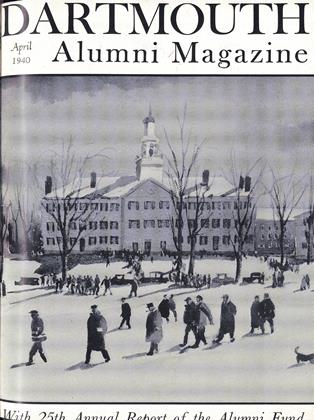THAT IMPORTANT FEATURE of any college, the Museum, which until recent years had been seemingly neglected on the Dartmouth Campus, has been showing such progress that today Wilson Hall is becoming one of the show places on the Dartmouth Campus,—yes, and important to students too. During the past year old exhibits have been revised and re-displayed, new glass cases have been installed in the large upstairs rooms, work-rooms have been fitted out down stairs, about 8,628 new items have been added to the collection, and some new devices have been added to make the exhibits more attractive. At present, besides the use by local students, high school and grade students have come for visits from all the neighboring towns.
Curator W. W. Bowen, assisted by Dr. Robert H. Dennison, assistant curator, has many interesting plans for the future. One of them is the development of the Indian exhibits from the New England States, in accordance with the tradition of the college as an Indian Institution. Another is the planning of possible fieldwork for students in the Hanover locality. Alumni interested in the Museum's work should be listed for the annual report of the Curator, a document too long to be printed here. But some very interesting things have been done. One is the arrangement of the fish of the Sanborn Collection. By use of successive glass layers, the fish room is slowly taking on the appearance of an aquarium with the fish swimming about as if in water. The purchases of African and Egyptian collections from the Reading Museum in England add a very fine display. Alumni can certainly help the college by notifying Curator Bowen when such exhibits as these are put on sale at reasonable prices. The exhibit of local birds has been revised and expanded. These, with the local mammal exhibit, and groups of invertebrates are in much more favorable showings. The Patten Collection of fossils from all parts of the world has been rearranged and displayed. A special case of non-breakable glass is being set up for the gold-work exhibit of Pre-Columbian America (donated by Mrs. V. M. Cutter)—the exhibit now resting in the treasurer's safe until the case is finished. Altogether the Museum has 90,311 items of exhibit, and its stock is increasing rapidly. Speaking of museums and exhibits, Curator Philip A. White of the Carpenter Galleries has given students and townspeople several treats this year, but during the month of March and continuing until April 9, an exhibition of old, interesting, or famous pictures from the homes of Hanover residents has been assembled in Carpenter. It was rather an unique idea to assemble such pieces, many of which came from attics and cellars, but the resuit is one that must be pleasing to anv one because of its diversities. Every kind of picture was brought out,—portrait crayon, pen and ink, landscape, watercolor, oil. To give the exhibit an intimate touch, the lender of each exhibit was asked to tell 'what he knew of artist or picture and this information was placed on a card by the side of the picture Whether or not anything of value has come to light is not determined at this time of writing, but before the exhibition is over, some resident may have discovered a Titian or a Tintoretto in moth balls in the attic. Alumni who visit the college in April will be interested to see this collection.
Another step in the direction of studentfaculty cooperation in extra-curricular activities is the appointment of Professor Sidney Cox of the English Department as an advisor on the board of the Dartmouth Pictorial. This choice, made by the Board itself, implies consultation upon material already submitted to the magazine, but the faculty member's duties do not include the responsibility of editing or assignment of material, although Professor Cox has said that he will be of service in any way that is desired. That much printable material comes into courses on English composition has been demonstrated by the publication "Dart" assembled by students in certain courses for many years past. As conditions at the present rather forbid the publication of classroom work, the Pictorial is attempting to include the best writing of the college in its pages, and as a consequence has requested Professor Cox to lend his aid.
Those persons who heard Professor Andrew Scarlett's lecture on "Plastics and Synthetic Fibers" at the Hanover Holiday last June, will be interested to know that Professor Scarlett's discussion of this subject, so much in the public mind at present, has been one of the most called-for lectures given by Hanover professors this year. Already the subject has been presented before the Lebanon Rotary Club, Newport Rotary Club, Lake Tarleton Club, Hanover Women's Club, Hanover High School and the Dartmouth Scientific Association. Three more requests have been made, including two preparatory schools and a club at Springfield, Vermont. The content of this lecture has been varied to suit the audience,—it has been cut to a half-hour, and it has also been extended to an hour and a half.
 View Full Issue
View Full Issue
More From This Issue
-
 Article
ArticleRich Man's College?
April 1940 By JOHN HURD JR '21 -
 Article
ArticleMeet Bill Daniels—
April 1940 By CHARLES E. WIDMAYER '30 -
 Class Notes
Class Notes1930*
April 1940 By Chairman, ALBERT I. DICKERSON -
 Sports
SportsBig Green Teams
April 1940 By Whitey Fuller '37 -
 Class Notes
Class Notes1925*
April 1940 By Chairman, FORD H. WHELDEN -
 Class Notes
Class Notes1938*
April 1940 By Chairman, CARL F. VON PECHMANN








